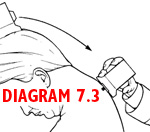MISS BESTER
Katherine Satorius
Why were Miss Bester's eyes always sad? Why did she cast them so often out of the windows, the tiny, simple schoolhouse windows with four squares of glass, beyond which there was only a block of sky stacked on a block of dull green? Six small windows, three per side, and twelve blocks in all, counted Mary, slow at math, six blocks of blue, six of green, and one flat line dividing them all, the flat line running all the way around. Miss Bester was always watching that line, and sometimes when Mary looked hard at Miss Bester's eyes (while bringing her an apple or standing at the chalkboard having been called upon to answer a question, and, rarely knowing the answer, watching Miss Bester's eyes fill with pity, the pity not covering up the sadness), sometimes while looking into Miss Bester's eyes Mary would study the green streaks in her blue irises. It was as if someone had churned up one of those small windows with the two color blocks—that was the color of Miss Bester's eyes, the sky and the grass, but the horizon line was missing.
Or was it? One day Mary looked into Miss Bester's eyes and found herself in a field, a perfectly flat field of green alfalfa under a cornflower blue sky. Now there was a fence, an old split-rail fence, and she was leaning against it, her plump arms white and smooth on the splintery wood. She was looking out at the line, at the horizon, and as she looked, two shapes advanced through the alfalfa. They were dark at first, but as they moved through the waving plants they grew lighter, and became people. One was rectangular and long and the other was smaller, rounder, and nipped in the middle. They became a young man in a white collared shirt and brown pants with suspenders and a young woman in a blueberry dress and a white apron and bonnet. The man became George, Mary's cousin. The woman became Miss Bester. They were right in front of Mary, but they did not seem to notice her. Mary looked down at her arms, her arms were still there. She brought one of her hands to her face, her face felt real. George had a picnic basket hooked on his elbow and Miss Bester reached in and pulled out a blanket, blue-and-white checked. George set the wicker basket down, smoothing the tall grass flat like hair. He and Miss Bester each took two corners and Mary watched the blanket billow and flap. They snapped it square and spread it over the grass and patted it flat. George sat and began to untie his shoes. His shoes were muddy, and the bottoms of his pants were muddy too, saw Mary. Miss Bester sat with her legs curled to the side under her skirts. One of her shoes, a leather bootie with buttons going up, protruded. The bootie was not muddy: Mary imagined George sweeping Miss Bester into his arms and carrying her over some mucky ditch earlier. Mary watched him hold Miss Bester's heel in his palm as he lifted her hem just above the tops of her boots and began to undo the buttons. Under her bonnet shade, Miss Bester smiled. The boot came off in George's hand. He set it down. Miss Bester giggled. She wiggled her toes under her black stockings and George covered them with his big hand.
Mary, do you know the answer?
A string of numbers had been
chalked on the board. There was a 7, a 3, a 4, a 9, an 11, a 12, and another
4. Between each pair was a plus or minus.
Mary, do you know what this
equals?
Eyes were upon her.
Her cousin George, incidentally,
was dead. He had had a fever.
She thought: Wait a minute.
On second glance, the eyes just
looked through her.
Zero? she said. It just came
to her.
Correct, said Miss Bester.
She remembered something: Miss
Bester was not alive, either.
On second glance, Miss Bester
did not have eyes. On second glance, she had two holes you could see grass
and sky through. You could put your hands through the holes and feel the
tips of the grass blades. You could feel the blue sky pressing down on
you. You could walk in there and see things that happened a very long
time ago. You could meet past people in there who walked around smiling,
wearing suspenders and unfastening buttons and carrying baskets and stepping
over ditches.
But wait a minute, thought Mary.
Miss Bester wiggled her toes under her black stockings. George removed the other bootie. Miss Bester's feet moved over the blue-checked cloth, nuzzling like two black cats.
Wait a minute, thought Mary. I don't think I am alive, either.
__
This grew from a series of short pieces focusing on various points in the distant past. The original idea was not to do any research but to rely on pre-existing knowledge that can't be traced to any source, or on collective-conscious-style impressions. (Recently I came across an interesting British artist, Emma Kay, who deals with this idea—you can see some of her work [here].
